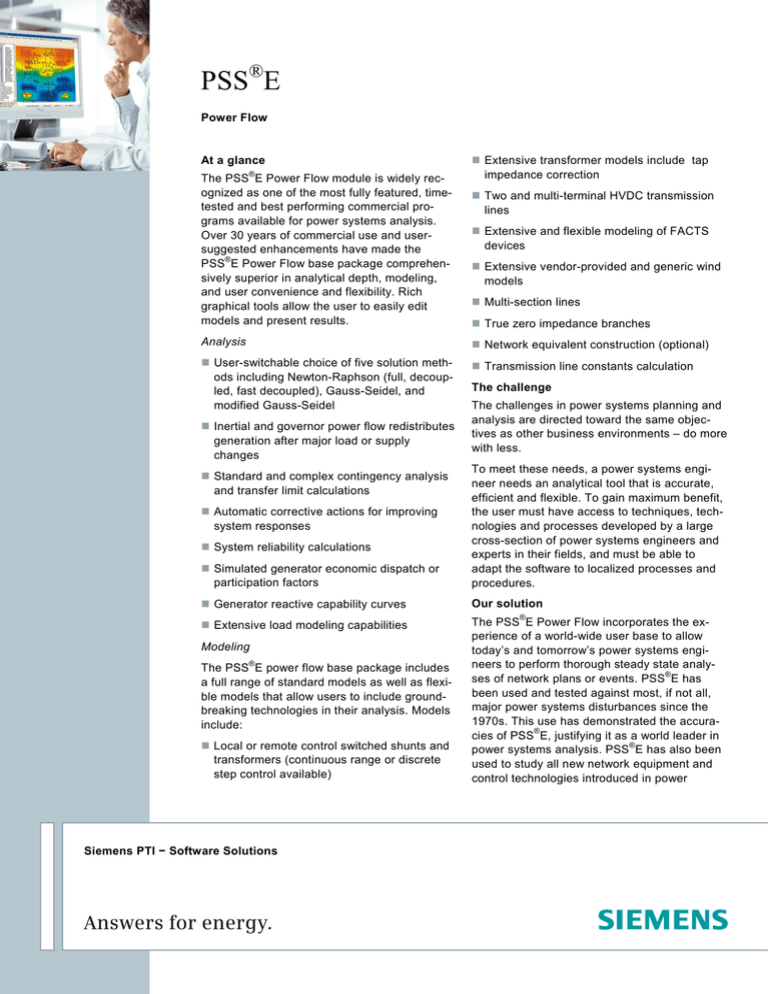
PSS®E
Power Flow
At a glance
®
The PSS E Power Flow module is widely recognized as one of the most fully featured, timetested and best performing commercial programs available for power systems analysis.
Over 30 years of commercial use and usersuggested enhancements have made the
®
PSS E Power Flow base package comprehensively superior in analytical depth, modeling,
and user convenience and flexibility. Rich
graphical tools allow the user to easily edit
models and present results.
Extensive transformer models include tap
impedance correction
Two and multi-terminal HVDC transmission
lines
Extensive and flexible modeling of FACTS
devices
Extensive vendor-provided and generic wind
models
Multi-section lines
True zero impedance branches
Analysis
Network equivalent construction (optional)
User-switchable choice of five solution methods including Newton-Raphson (full, decoupled, fast decoupled), Gauss-Seidel, and
modified Gauss-Seidel
Transmission line constants calculation
Inertial and governor power flow redistributes
generation after major load or supply
changes
The challenge
The challenges in power systems planning and
analysis are directed toward the same objectives as other business environments – do more
with less.
Simulated generator economic dispatch or
participation factors
To meet these needs, a power systems engineer needs an analytical tool that is accurate,
efficient and flexible. To gain maximum benefit,
the user must have access to techniques, technologies and processes developed by a large
cross-section of power systems engineers and
experts in their fields, and must be able to
adapt the software to localized processes and
procedures.
Generator reactive capability curves
Our solution
Extensive load modeling capabilities
The PSS®E Power Flow incorporates the experience of a world-wide user base to allow
today’s and tomorrow’s power systems engineers to perform thorough steady state analy®
ses of network plans or events. PSS E has
been used and tested against most, if not all,
major power systems disturbances since the
1970s. This use has demonstrated the accuracies of PSS®E, justifying it as a world leader in
power systems analysis. PSS®E has also been
used to study all new network equipment and
control technologies introduced in power
Standard and complex contingency analysis
and transfer limit calculations
Automatic corrective actions for improving
system responses
System reliability calculations
Modeling
®
The PSS E power flow base package includes
a full range of standard models as well as flexible models that allow users to include groundbreaking technologies in their analysis. Models
include:
Local or remote control switched shunts and
transformers (continuous range or discrete
step control available)
Siemens PTI − Software Solutions
systems over this same time period.
The result is a software package that is
accurate and versatile in modeling power
systems.
But, of equal importance to the PSS®E
accuracy and modeling flexibility is the
improvement of the engineer’s efficiency
through using PSS®E. The user interface
in PSS®E is based on a full-graphical
representation of the network and rich
®
Microsoft Excel -like data spreadsheets
used to manipulate the data and present
the results. In combination, these two
presentations, and others, allow the
engineer to clearly understand the data
and analyses.
®
Additionally, what differentiates PSS E
is its open data structure and user controllability. World-wide experience has
shown that any analytical tool must be
prepared to perform major studies “out of
the box” as well as allow for user differences in standards and practices world®
wide. PSS E exceeds these needs
through its fully open data structure and
integration with the Python scripting
language. These characteristics provide
®
user control of the PSS E execution and
preparation of customized results presentation.
®
The PSS E Power Flow offers outstanding accuracy, user efficiency, and
flexibility.
Application example
®
PSS E offers tools for both deterministic
and probabilistic reliability assessment.
®
The PSS E Automatic AC Contingency
Computation and Multi-Level AC Contingency Computation (ACCC/MACCC)
features can be used to perform deterministic reliability assessment, while the
®
PSS E probabilistic methods provide
another dimension to system planning.
The automatic contingency analysis
processes user-specified and automatically-selected single and multiple contingencies within one run. User specified
and automatically generated contingen-
Published by and copyright © 2009:
Siemens Energy Inc.
Power Distribution, T&D Service Solutions
Siemens Power Technologies International
400 State Street
PO Box 1058
Schenectady, NY 12301-1058
www.siemens.com/energy/power-technologies
cies can be tested individually or combined with each other as overlapping
outages of up to three levels (N-3). The
contingency enumeration process is
based on the use of several built-in contingency ranking schemes which provide
tremendous savings in computation
effort by avoiding the explicit evaluation
of contingencies that are not likely to
affect system reliability.
Automatic contingency analysis also
features generation dispatch, a nondivergent power flow solution algorithm,
tripping simulation and corrective action.
Figure 1 outlines the computational procedures in performing a deterministic
reliability assessment.
Base Case
Apply Contingency from List
Generation/Load
Imbalance?
Perform Generation Dispatch
Yes
No
Apply Tripping Action
Solve Power Flow
Diverged?
Yes
Trip Sequence
Activated?
No
No
Yes
Converged?
No
Overload or Voltage
Problems?
Yes
Apply Corrective Actions
Store Contingency Results
Figure 1 - Computational procedures in a contingency analysis
Within the automatic contingency analysis process, a new load flow solution is
developed whenever trip sequences are
triggered. The tripping option can be
applied to model special protection
schemes (SPS), to simulate cascading
outages in severely overloaded conditions, and many other complex events.
Corrective action functions can be applied to simulate operator responses,
such as the re-dispatch of generation,
curtailment of load and adjustment of
phase-shifting transformers. This translates system-based reliability measures,
such as the location and magnitude of
branch overloads and bus voltage violations, to customer-impact indices in
terms of the potential amount of service
interruptions.
Siemens AG
Energy Sector
E D SE PTI
Freyeslebenstrasse 1
91058 Erlangen, Germany
Siemens Transmission and Distribution Ltd
PTI
Sir William Siemens House, Princess Road
Manchester, M20 2UR
United Kingdom
Probabilistic transmission reliability incorporates the impact of frequency and
average duration of equipment outages
on system reliability assessment. Bulk
reliability measures are obtained relative
to various system problems, including
branch overloads, load interruptions,
voltage limit violations, and voltage collapse conditions. These indices provide
a better indication of power system reliability by taking into consideration the
relative likelihood of different contingencies that may occur (see Figure 2).
Apply Non-Divergent
Power Flow
No
Yes
®
PSS E provides several functions to
post process results for reporting. The
Single ACCC report function provides
seven types of reports and Multiple
ACCC runs compare up to nine contingency runs. Python programs allow users to extract data stored in contingency
result files for use when creating their
own reports.
The basic contingency analysis process
can be extended to assess the steady
state power transfer capabilities in a
power system. The capability of transmission system to support power transfers is a measure of interconnected
transmission system reliability. The
®
PSS E functions for transfer capability
study include the transmission interchange limits calculation (TLTG) and
interchange limits with two opposing
systems (POLY).
®
The PSS E reliability functions allow for
deterministic reliability to evaluate certainty of service, and for probabilistic
analysis to evaluate consequences that
can be expressed in terms of cost.
RELIABILITY INDICES FOR SYSTEM LOSS OF LOAD
LOAD CURTAILMENTS
(MW)
ENTIRE SYSTEM
0.0 --100.0
100.0 --200.0
200.0 --300.0
CONTINGENCY LEGEND:
LABEL
EVENTS
12_789
: OPEN LINE FROM BUS 4105 [MAINSUB
OPEN LINE FROM BUS 2106 [NRIVER
BREAKER_FAIL: trip branch from BUS 1341 to BUS
trip branch from BUS 1461 to BUS
trip branch from BUS 3201 to BUS
EAST_WEST : trip branch from BUS 1061 to BUS
trip branch from BUS 1861 to BUS
trip branch from BUS 1631 to BUS
NO.OF
CONT.
822
481
778
63
WORST CONT.
12_789
BREAKER_FAIL
EAST_WEST
138.00] TO BUS 2110 [EAST-TIE 138.00] CKT 1
138.00] TO BUS 2110 [EAST-TIE 138.00] CKT 1
1701 CIRCUIT 1
14619 CIRCUIT 1
14619 CIRCUIT 1
10619 CIRCUIT 1
10619 CIRCUIT 1
10619 CIRCUIT 1
Figure 2 - Probabilistic reliability assessment
results
For more information, please contact
our Customer Support Center.
Phone: +49 180 524 70 00
Fax:
+49 180 524 24 71
(Charges depending on provider)
E-mail: support.energy@siemens.com
Power Distribution Division
Printed in Germany
Printed on elementary chlorine-free
bleached paper.
FREQ. DURATION PROB. POWER INT. ENG CURT
(OC/Y) (HOUR)
(MW/Y)
(MWH/Y)
0.8652
12.6 0.0012
90.6
632.5
0.4331
12.4 0.0006
98.1
456.1
0.5050
31.8 0.0018
180.1
1132.3
0.0549
10.2 0.0001
135.1
2.6
All rights reserved.
Trademarks mentioned in this document
are the property of Siemens AG, its affiliates,
or their respective owners.
Subject to change without prior notice.
The information in this document contains general
descriptions of the technical options available,
which may not apply in all cases.
The required technical options should therefore be
specified in the contract.
SWPE02-EN-200905

